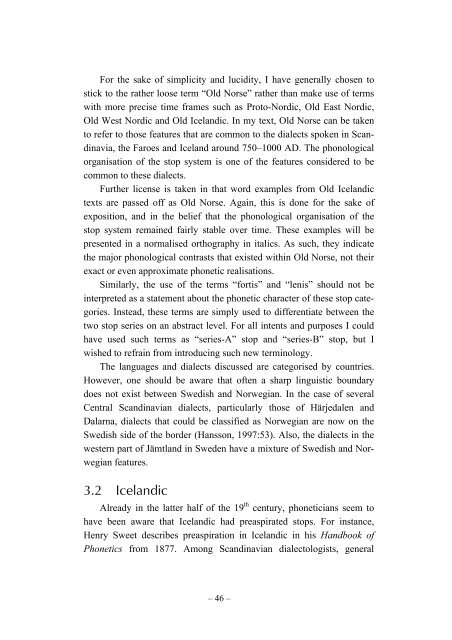Preaspiration in the Nordic Languages: Synchronic and Diachronic ...
Preaspiration in the Nordic Languages: Synchronic and Diachronic ...
Preaspiration in the Nordic Languages: Synchronic and Diachronic ...
You also want an ePaper? Increase the reach of your titles
YUMPU automatically turns print PDFs into web optimized ePapers that Google loves.
For <strong>the</strong> sake of simplicity <strong>and</strong> lucidity, I have generally chosen to<br />
stick to <strong>the</strong> ra<strong>the</strong>r loose term “Old Norse” ra<strong>the</strong>r than make use of terms<br />
with more precise time frames such as Proto-<strong>Nordic</strong>, Old East <strong>Nordic</strong>,<br />
Old West <strong>Nordic</strong> <strong>and</strong> Old Icel<strong>and</strong>ic. In my text, Old Norse can be taken<br />
to refer to those features that are common to <strong>the</strong> dialects spoken <strong>in</strong> Sc<strong>and</strong><strong>in</strong>avia,<br />
<strong>the</strong> Faroes <strong>and</strong> Icel<strong>and</strong> around 750–1000 AD. The phonological<br />
organisation of <strong>the</strong> stop system is one of <strong>the</strong> features considered to be<br />
common to <strong>the</strong>se dialects.<br />
Fur<strong>the</strong>r license is taken <strong>in</strong> that word examples from Old Icel<strong>and</strong>ic<br />
texts are passed off as Old Norse. Aga<strong>in</strong>, this is done for <strong>the</strong> sake of<br />
exposition, <strong>and</strong> <strong>in</strong> <strong>the</strong> belief that <strong>the</strong> phonological organisation of <strong>the</strong><br />
stop system rema<strong>in</strong>ed fairly stable over time. These examples will be<br />
presented <strong>in</strong> a normalised orthography <strong>in</strong> italics. As such, <strong>the</strong>y <strong>in</strong>dicate<br />
<strong>the</strong> major phonological contrasts that existed with<strong>in</strong> Old Norse, not <strong>the</strong>ir<br />
exact or even approximate phonetic realisations.<br />
Similarly, <strong>the</strong> use of <strong>the</strong> terms “fortis” <strong>and</strong> “lenis” should not be<br />
<strong>in</strong>terpreted as a statement about <strong>the</strong> phonetic character of <strong>the</strong>se stop categories.<br />
Instead, <strong>the</strong>se terms are simply used to differentiate between <strong>the</strong><br />
two stop series on an abstract level. For all <strong>in</strong>tents <strong>and</strong> purposes I could<br />
have used such terms as “series-A” stop <strong>and</strong> “series-B” stop, but I<br />
wished to refra<strong>in</strong> from <strong>in</strong>troduc<strong>in</strong>g such new term<strong>in</strong>ology.<br />
The languages <strong>and</strong> dialects discussed are categorised by countries.<br />
However, one should be aware that often a sharp l<strong>in</strong>guistic boundary<br />
does not exist between Swedish <strong>and</strong> Norwegian. In <strong>the</strong> case of several<br />
Central Sc<strong>and</strong><strong>in</strong>avian dialects, particularly those of Härjedalen <strong>and</strong><br />
Dalarna, dialects that could be classified as Norwegian are now on <strong>the</strong><br />
Swedish side of <strong>the</strong> border (Hansson, 1997:53). Also, <strong>the</strong> dialects <strong>in</strong> <strong>the</strong><br />
western part of Jämtl<strong>and</strong> <strong>in</strong> Sweden have a mixture of Swedish <strong>and</strong> Norwegian<br />
features.<br />
3.2 Icel<strong>and</strong>ic<br />
Already <strong>in</strong> <strong>the</strong> latter half of <strong>the</strong> 19 th century, phoneticians seem to<br />
have been aware that Icel<strong>and</strong>ic had preaspirated stops. For <strong>in</strong>stance,<br />
Henry Sweet describes preaspiration <strong>in</strong> Icel<strong>and</strong>ic <strong>in</strong> his H<strong>and</strong>book of<br />
Phonetics from 1877. Among Sc<strong>and</strong><strong>in</strong>avian dialectologists, general<br />
– 46 –

















